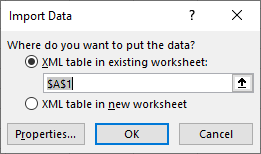
The schema reference can be added as anĪttribute of the root element, like this: To attach an XML file to a schema a reference to the schema file mustīe included inside the XML file.

Tips.You can unmap XML elements you don't want to use, or to prevent the contents of cells from being overwritten when you import XML data. The cell will be unmerged, and the element will be mapped to the cell where the pointer is located. This is expected behavior, because repeating elements are designed to work with unmerged cells only.You can map single, nonrepeating XML elements to a merged cell, but mapping a repeating XML element (or an element that contains a repeating element) to a merged cell isn't allowed. You should save these files if you want to add XML Maps to other workbooks.Map the XML elements to the table to make it an XML table.When you map a repeating XML element to a merged cell, Excel unmerges the cell. If you want the new table to be an XML table, do the following.Add an XML Map to the new workbook by using the.xml or.xsd file you used to create the original XML Map. Instead of copying the XML table, Excel creates an Excel table that contains the same data. This XML Map is stored in the workbook, but when you copy the XML table to a new workbook, the XML Map isn't automatically included. Click Review Share Workbook to verify that and to remove it from shared use as needed.If you want to map XML elements in a workbook you want to share, map the XML elements to the cells you want, import the XML data, remove all of the XML maps, and then share the workbook.If you can't copy an XML table that contains data to another workbook, the XML table might have an associated XML Map that defines the data structure. Notes.If all XML commands are dimmed, and you can't map XML elements to any cells, the workbook might be shared. Excel doesn't support the simple content of the complex type but does support the child tags and attributes defined in that complex type.Use sample XML schema and XML data filesThe following sample data has basic XML elements and structures you can use to test XML mapping if you don't have XML files or text files to create the XML files. An element indicates it's a member of another element's substitution group through the attribute.Mixed content This content is declared by using mixed='true' on a complex type definition. Excel doesn't support recursive structures more than one level deep.Abstract elements These elements are meant to be declared in the schema, but never used as elements.Ībstract elements depend on other elements being substituted for the abstract element.Substitution groups These groups allow an element to be swapped wherever another element is referenced. This element allows you to include attributes that aren't declared by the schema.Recursive structures A common example of a recursive structure is a hierarchy of employees and managers in which the same XML elements are nested several levels. This element allows you to include elements that aren't declared by the schema. The following XML schema element constructs can't be imported into Excel.

Notes.There are several types of XML schema element constructs Excel doesn't support.

You can then use both Access and Excel to convert that text file to the XML files you need. For example, you might have a line-of-business application that exports data into these XML file formats, a commercial web site or web service that supplies these XML files, or a custom application developed by your IT department that automatically creates these XML files.If you don’t have the necessary XML files, you can create them by saving the data you want to use as a text file. Tip: You'll find more information about using XML with Excel in this.Locate or create XML schema and XML data filesIf another database or application created an XML schema or XML data file, you might already have them available.


 0 kommentar(er)
0 kommentar(er)
